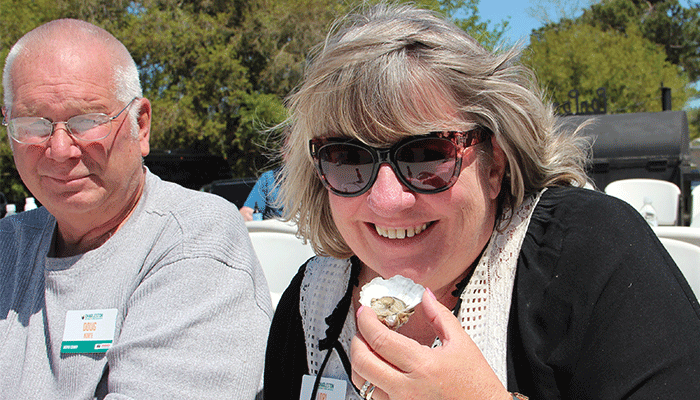Getting a taste of the Lowcountry
Author
Published
4/17/2023
The gnats were swarming — they do that in the spring in the Lowcountry of South Carolina — but nobody seemed to mind.
After all, in a few moments Farm Bureau members would hop on board one of the skiffs for a 10-mile journey along Mosquito Creek into the Ashepoo River, which eventually leads southeast to the Atlantic Ocean. They wouldn’t have to go quite that far before coming upon a series of oyster pots along the shoreline managed by Trey McMillan, president of Lowcountry Oyster Company, and his crew.
Maneuvering in and shutting off the motor, McMillan told the roughly 60 Farm Bureau county presidents and their guests from Iowa, across two boat trips, that he has three plots housing 1,000 cages each filled with growing oysters that he harvests 52 weeks per year.
“I’d say there’s probably a million and a half oysters right here alone,” he told the group at one of the plots. “Each oyster filters up to 50 gallons of water a day.
“In total, we have about 20 miles of lease we maintain. It really takes a village to do this. We build everything by hand, everything is harvested by hand, and everything is counted by hand. The season never ends.”
Roughly 5 million oysters are growing along the riverbanks, with another 2.5 million getting their start in the nursery. “We have another 10 million coming to the nursery in the next couple months,” McMillan said.
It’s a fascinating tale of innovation and persistence dating back to 2015, when McMillan took his own trip to an oyster farm in the Chesapeake Bay and two years later founded Lowcountry Oyster Company, known for using sustainable farming practices and the latest technology.
On this day, he was thrilled to share his journey with Farm Bureau members from Iowa during a farm tour March 30 that stressed the science and sustainability of an oyster’s life cycle, as well as the development of his business from the ground up and his own farming practices.
Labor availability
Back onshore, crew members took guests through the nursery that accommodates oysters as tiny as a few grains of sand, then through the harvesting shack, where viable adult oysters are
sorted and readied for shipment across the south and east.
County presidents had the opportunity to sample the fresh product and ask questions, taking note of the similarities and challenges facing South Carolina and Iowa farmers such as labor availability and pests, or the hurdles and obstacles facing beginning farmers.
McMillan said his most notable challenge is labor. He has 13 full-time employees and another 20 part-time harvesters, but he’s constantly looking for that quality employee to invest in.
“The hardest part of the whole operation is employees,” he said. “We go through a good many before we find one that really sticks out and we start investing in with knowledge and responsibility.”
He said he treats everyone like family. “We take care of our core group of full-time employees with shares in bonuses,” he explained. “The harder we all work the better the company does and the better everyone and their families do.”
Similar challenges
Like Iowa, McMillan and other South Carolina farmers find themselves faced with several ongoing challenges.
Harry Ott, South Carolina Farm Bureau President, addressed the county president’s group earlier in the week, and echoed McMillan’s assessment regarding maintaining a viable workforce.
“We have a whole lot of people, but we have very little labor that wants to work out in the fields bending over a plant and picking leafy greens,” Ott said.
Additionally, Ott said like Iowa, South Carolina Farm Bureau continually works with the state’s legislators on ag issues, and today there are many newcomers that maybe don’t know much about the state’s ag production, even though it’s the number one industry in South Carolina.
“Relationships….that’s what it’s all about,” Ott said. “They’ve got to understand what we do for a living and the things that we need to be successful. We have to tell our story to the politicians.”
South Carolina battles its own pest problems, too, albeit different than Iowa. While both have deer populations, the Palmetto state has a growing feral hog concern, while in Iowa it may be raccoons. Ott says work now to keep feral pigs away.
“We are losing in excess of $200 million a year in ag products just to feral hogs and deer,” he said.
“But the biggest threat to ag that we have right now is the loss of ag farmland. That’s unsustainable.” Developers offer as much as $65,000 per acre for a farmer’s land, he said.
South Carolina’s Farm Bureau is championing an effort to secure funding to purchase a farmer’s development rights, thereby providing the farmer with some needed cash but also keeping the land in production for decades to come.
Iowa’s Farm Bureau county presidents were listening, sharing ideas and bringing home solutions to the similar problems they all face, whether it be on policy development or how to keep feral hogs away. Those conversations likely are being held now at the county level, in the coffee shop or at a track meet.
Winneshiek County’s Jerome Fulsaas perhaps said it best following the oyster boat tour. There’s no doubt that farmers across the United States have comparable challenges and successes. Being able to observe others, become educated, and provide solutions back home are the benefits Iowa Farm Bureau appreciates during such a trip.
Consider the oyster farm, he said. It’s aquaculture, but the premise is the same.
“Oyster farming isn’t that much different from us raising livestock in Iowa,” he said. “They’re trying to provide the ideal environment for their oysters to grow the most efficient way as possible, just as we are back home.”

Pictured above: Doug and Lori Korte from Jasper County taste fresh oysters on a day trip to the Lowcountry Oyster Farm in South Carolina. PHOTO / BOB BJOIN